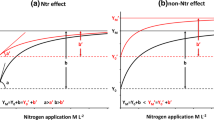Abstract
Long-term experiments designed to measure the effects of residues from phosphorus fertilizer applications on successive crops of wheat in Australia, and of soybeans in Brazil, showed that effects vary markedly in successive years because of uncontrolled variations in growing conditions. These variations constitute a serious problem in the prediction of residue effects from the results of fertilizer experiments. Given the time requirement and expense of long-term experiments, it does not seem practicable to attempt to solve the problem by carrying out a sufficient number of experiments to provide bases for statistical estimates, with allowance for variability in growing conditions during sequences of several years.
The possibility of transforming yield data to percentages of maximum attainable yields for the year of the experiments, to reduce or avoid the problem is examined. It is concluded that this simple and popular device is not satisfactory. Apart from the problems of estimating and predicting maximum yields, the experimental data show that yield response to fertilizers is not simply proportional to level of yield for individual years.
The usefulness of substitution rates, expressing the effectiveness of fertilizer residues as a proportion of equivalent fresh fertilizer applications, is also examined. Although this device may effectively reduce the problem of variation from that of sequences of years to that for the reference year for the fresh application, it is not considered potentially useful because rates vary with both the yield level nominated for the calcuation, and with combinations of fresh and previous fertilizer rates possible for a nominated yield.
Effects of fertilizer residues on soil composition were shown, using a standard soil test procedure for phosphorus fertilizer requirements. Since soil tests can be used to predict fertilizer yield functions, with statistical allowance for uncontrolled variations in growing conditions, it is suggested that residue effects are better measured by soil analyses than by fertilizer experiments.
Similar content being viewed by others
References
Alvey NG, Banfield CF, Baxter RI, Gower JC, Krzanowski WJ, Lane PW, Leech PK, Nelder JA, Payne RW, Phelps KM, Rogers CE, Ross GJS, Simpson HR, Todd AD, Wedderburn, RWM, Wilkinson GN (1977) GENSTAT. A General Statistical Program. (Rothamsted Experimental Station)
Colwell JD (1963) The estimation of phosphorus fertilizer requirements of wheat in southern N.S.W. by soil analysis. Aust J Exp Agric Anim Husb 3:190–7
Colwell JD (1977) National Soil Fertility Project. I. Objectives and Procedures (CSIRO, Div Soils: Adelaide)
Colwell JD (1978) Computations for studies of soil fertility and fertilizer requirements (Commonwealth Agric Bur: Slough, England/CSIRO: Australia)
Colwell JD (1979) National Soil Fertility Project. II. Soil Fertility Relationships (CSIRO Div. Soils: Adelaide)
Colwell JD (1983) Fertilizer Requirements. In Soils: ‘An Australian Viewpoint’, Division of Soils, CSIRO, pp. 795–815. (CSIRO, Melbourne/Academic Press, London)
Colwell JD and Morton R (1984) Development and evaluation of general or transfer models of relationships between wheat yields and fertilizer rates in southern Australia. Aust J Soil Res 22(2) (in press)
EMBRAPA/CPAC (1981) Relatório Técnico Anual do Centro de Pesquisa Agropecuária dos Cerrados 1979–1980. Planaltina-DF, Brazil
Goedert WJ (1983) Management of the Cerrado soils of Brazil: a review. J Soil Sci 34:405–428
John JA and Quenouille MH (1977) Experiments: design and analysis (Charles Griffin: London)
Kendall MG and Stuart A (1976) The advanced Theory of Statistics. Vol. 1. Edition 3, 231–235. London, Charles Griffin, 1976
Soil Survey Staff (1975) Soil Taxonomy — a basic System of Soil Classification for Making and Interpreting Soil Surveys. (USDA: Washington, DC)
Stace HCT, Hubble GD, Brewer R, Northcote KH, Sleeman JR, Mulcahy MJ and Hallsworth EG (1968) A Handbook of Australian Soils. (Rellim Tech. Publs: Glenside, S. Aust)
Williams EG and Reith JWS (1971) Residual effects of phosphate and the relative effectiveness of annual and rotational dressings. G.B. Minist Agric Fish Food Tech Bull. No. 20, pp. 16–23
Author information
Authors and Affiliations
Rights and permissions
About this article
Cite this article
Colwell, J. Fertilizing programs. Fertilizer Research 8, 21–38 (1985). https://doi.org/10.1007/BF01048904
Accepted:
Issue Date:
DOI: https://doi.org/10.1007/BF01048904




